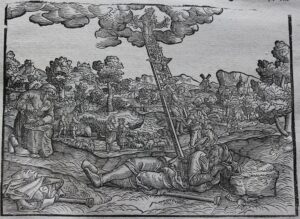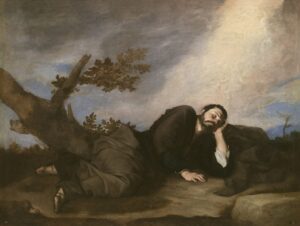The many rituals of Freemasonry have formed through centuries of tradition and the passing of knowledge from one generation to the next. Allegories conveying the ethical principles which, when followed, might allow a man to lead a good and virtuous life continue to be shared in lodges spanning the globe. Within these lessons are symbols from the ancient world – cyphers that have guided men in thought and deed long before speculative masonry arose in Europe during the Middle Ages. One such emblem of antiquity presents itself within the first degree: Jacob’s Ladder.

A picture of the Jacob’s Ladder from the original Luther Bibles
The Ladder to Heaven
Jacob’s Ladder first appears during the dream of Jacob in Genesis 28:10-22. The passage, which occurs during Jacob’s journey to Beersheba, reads:
And Jacob went out from Beer-sheba, and went toward Haran. And he lighted upon the place, and tarried there all night, because the sun was set; and he took one of the stones of the place, and put it under his head, and lay down in that place to sleep. And he dreamed, and behold a ladder set up on the earth, and the top of it reached to heaven; and behold the angels of God ascending and descending on it. And, behold, the LORD stood beside him, and said: ‘I am the LORD, the God of Abraham thy father, and the God of Isaac. The land whereon thou liest, to thee will I give it, and to thy seed. And thy seed shall be as the dust of the earth, and thou shalt spread abroad to the west, and to the east, and to the north, and to the south. And in thee and in thy seed shall all the families of the earth be blessed.
Like most biblical passages, the meaning of Jacob’s dream has long been debated. However, despite variations on the ladder’s interpretation across the three Abrahamic religions – Islam, Christianity, and Judaism – it shares similar significance within each. It is considered a metaphorical path to heaven; a means by which we receive gifts from heaven; and, by one interpretation, a manifestation of the progress of man and the behaviors that bring us closer to God.

Jacob’s Dream by José de Ribera depicts a sleeping Jacob and the ladder of his dream behind. Museo del Prado, Madrid, 1639.
The Masonic Ladder
The Masonic Ladder is unlike any other in the Craft in that it is a symbol directly taken from the Bible. It appears in the Entered Apprentice degree of the Blue Lodge as well as in the degrees of York Rite Masonry. Interestingly, the ladder is also unique in that its depiction and significance do vary slightly between the different degree systems.
It is thought the Masonic Ladder entered ritual in 1776 when Brother Thomas Dunckerly adopted it from ancient Hermetic traditions. Dunckerley, for his part, was a prominent Freemason in England likely to have created the Mark Degree. He heavily promoted Royal Arch Masonry and was the first Grand Master of the Masonic Order of the Knights Templar. However, while this was the first occasion of using the ladder in ritual, Trestle Boards depicting the ladder have been found predating Dunckerly.
The First Degree
A core symbol of the Entered Apprentice degree, the ladder is often depicted with three ‘staves or rounds’ disappearing into the sky, or heavenly light, with the sun, moon, and stars encircling it. The first degree ritual illustrates to the candidate that the rounds represent the three ‘theological virtues” of Faith, Hope, and Charity. Other interpretations offer that they denote the three chapters of life: youth, adulthood, and old age. Still, another way to consider the ladder is that it embodies the journey of a new Mason.
Bro. W.L. Wilmhurst wrote in his The Masonic Initiation, “Jacob’s vision and ladder, therefore, exemplify the attainment of Initiation, the expansion of consciousness that comes when the Light of the centre is found.” When taken as Wilmhurst described, Jacob’s Ladder reveals how the ethical teachings of Freemasonry can lead us towards heaven. As we work in life to serve our brethren, communities, and God, we fulfill our moral obligations, nourish our spirit and ascend the ladder.